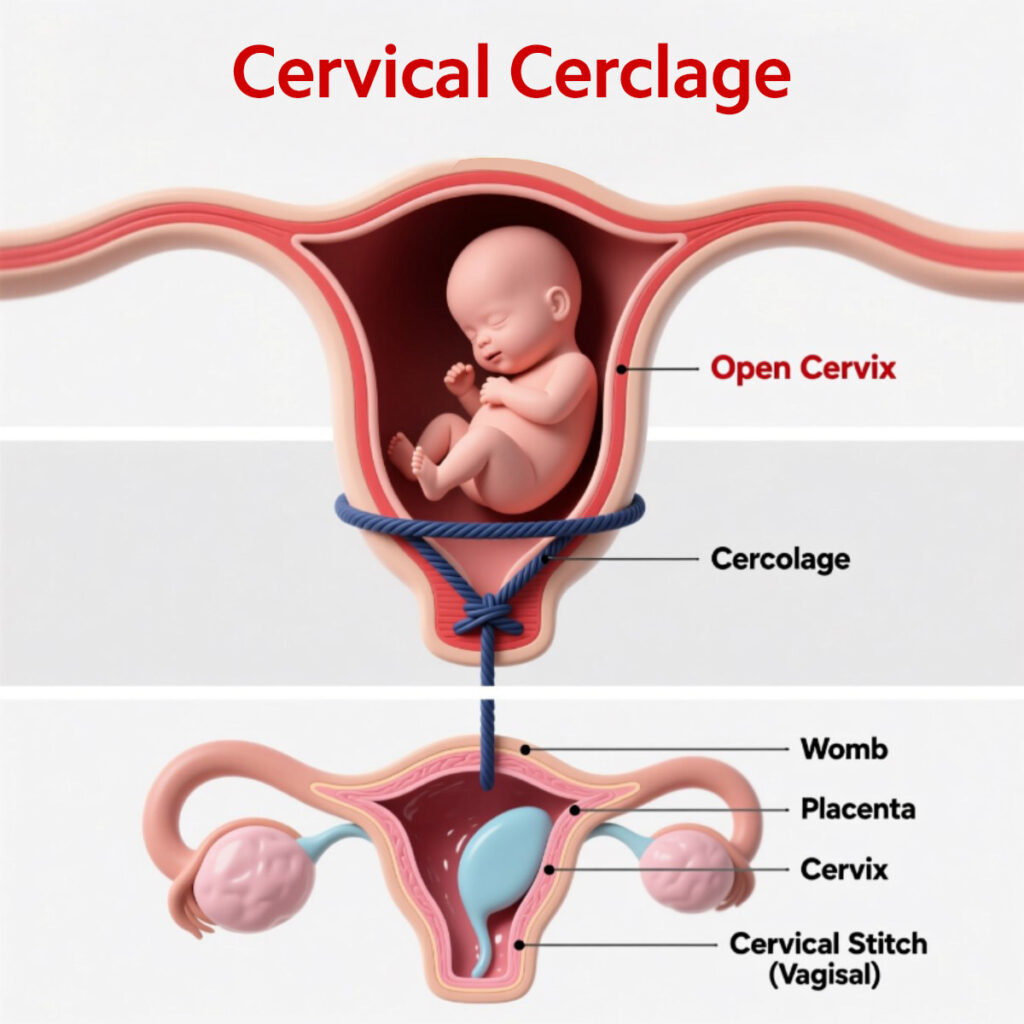Pregnancy is a delicate journey, and for some women, maintaining a healthy cervix is crucial to preventing early delivery. Cervical cerclage is one such procedure that helps support the cervix and reduce the risk of preterm birth or misscarrige. Let’s explore what it involves, when it’s needed, and what to expect after the procedure.
1. What Is a Cervical Cerclage?

A cervical cerclage is a medical procedure in which the cervix (the lower part of the uterus) is stitched closed during pregnancy to prevent it from opening too early. This helps support the growing baby until full term.
It is commonly recommended for women with incompetent cervix — a condition where the cervix begins to shorten or open prematurely, leading to miscarriage or preterm birth. The stitch is typically removed around the 37th week of pregnancy, just before delivery.
2. Is a Cervical Cerclage Major Surgery? Breaking Down the Procedure
Technically, a cervical cerclage is a minor surgical procedure, but it requires precision and careful monitoring. It is usually performed under regional (spinal) or general anesthesia and takes about 30–45 minutes.
While it’s less invasive than other procedures, it is still a critical intervention that plays a major role in sustaining pregnancy.
Who is a candidate for a cervical cerclage?

A cervical cerclage is recommended for women who:
- Have a history of second-trimester miscarriages due to cervical weakness
- Have a short cervix detected through ultrasound
- Experience painless cervical dilation early in pregnancy
Is cervical stitch mandatory for twin pregnancy?
A cervical stitch is not always mandatory for twin pregnancies, but it may be advised if cervical length shortens significantly or if there is a history of preterm birth.
Is a cervical cerclage painful?
Most women experience mild discomfort or cramping after the procedure, but pain is usually manageable with rest and prescribed medication.
What is the cost of cervical cerclage?
The cost of cervical cerclage in India varies depending on the hospital, type of procedure, and medical condition. It generally ranges between ₹20,000–₹50,000.
3. When is the Best Time for Cervical Cerclage? – Timing & Success
Timing plays a crucial role in the success of a cervical cerclage. Placing the stitch at the right stage of pregnancy can make a significant difference in preventing early cervical dilation and ensuring the baby’s healthy development. The best time for cervical cerclage or the best time to do cervical cerclage usually depends on your medical history, cervical length, and overall pregnancy health. Let’s understand when this procedure is most effective, how long it lasts, and what factors influence its success.
How long does cervical cerclage last?
The stitch usually remains in place until 37 weeks of pregnancy or until labor begins.
When is it too late for cerclage?
The best time for cervical cerclage or the best time to do cervical cerclage is between 12 and 14 weeks of pregnancy. After 24 weeks, the risks increase, and cerclage may not be as effective.
What is the success rate of cerclage?
Success rates are high—over 80–90% of women with cervical cerclage carry their pregnancies to a viable gestational age.
What is the most common week for incompetent cervix?
An incompetent cervix often becomes noticeable between 16 to 24 weeks, when the cervix starts to shorten or open early.
What is the success rate of cerclage at 24 weeks?
If performed around 24 weeks, the success rate may reduce slightly but still offers a good chance of prolonging pregnancy when managed with rest and close monitoring.
What is a good cervix length for pregnancy?
A cervix length of 3.0–4.0 cm is considered normal. If it shortens to less than 2.5 cm before 24 weeks, a cervical stitch might be advised.
Abdominal vs. Transvaginal: Which Cerclage is Best for Me?
There are two main types:
- Transvaginal cerclage – Done through the vagina, commonly recommended.
- Abdominal cerclage – Done through the abdomen, advised when transvaginal cerclage isn’t possible or has failed previously.
Abdominal cerclage before pregnancy can be planned for women with recurrent cervical insufficiency. It can also be performed as abdominal cerclage during pregnancy (around 11–14 weeks), though it involves a longer recovery period.
Can you have a successful pregnancy with an incompetent cervix?
Yes, with timely diagnosis and proper management like cerclage, many women have a successful full-term pregnancy despite an incompetent cervix.
How many minutes does cerclage take?
The procedure typically takes 30–45 minutes under anesthesia, followed by a few hours of monitoring.
4. Cervical Cerclage: Warning Signs
While a cervical cerclage is generally considered safe and effective, it’s essential to stay alert for any unusual signs after the procedure. Early detection of complications can help protect both the mother and baby from potential risks. Understanding the warning signs after cerclage—such as pain, bleeding, or fluid leakage—allows timely medical intervention and better pregnancy outcomes. Let’s see how risky a cervical stitch can be, what side effects may occur, and which symptoms require immediate attention.
How risky is a cervical stitch and what are the side effects?
Cervical cerclage is generally safe, but like any medical procedure, it carries minor risks such as:
- Mild bleeding or spotting
- Cramping
- Infection
- Premature rupture of membranes
What are the warning signs after cerclage?
Seek medical help if you experience:
- Heavy bleeding or contractions
- Leakage of fluid (possible sign of water breaking)
- Fever or chills
- Persistent pain or pressure
What are the warning signs of an incompetent cervix?
Signs include:
- Pelvic pressure
- Backache
- Increased vaginal discharge
- Spotting in the second trimester
Can I still miscarry with a cerclage?
While cerclage reduces miscarriage risk, it does not guarantee prevention. Close follow-up, rest, and adherence to your doctor’s advice significantly improve outcomes.
5. Life After Cervical Cerclage: Essential Do’s and Don’ts
What not to do after cervical cerclage?
- Avoid lifting heavy weights, strenuous exercise, or sexual activity without medical clearance.
- Avoid long travel and unnecessary physical strain.
Is bed rest required after cervical cerclage?

Light bed rest is often recommended for a few days after the procedure. However, strict bed rest may not be necessary unless advised by your doctor.
Can we travel after a cervical stitch?
Travel should be limited, especially long-distance, during the first few weeks after cervical cerclage. Always consult your gynecologist before traveling.
After Cervical Cerclage: Life and Pregnancy
After cervical cerclage, most women lead a normal pregnancy with regular check-ups and gentle precautions. Doctors may schedule ultrasounds to monitor cervical length and ensure no infection or early labor signs. When labor begins or at 37 weeks, the stitch is safely removed.
Many women have gone on to deliver healthy babies after cervical stitch pregnancy, thanks to early intervention and expert care.
Conclusion: Expert Care at Ankuran IVF Clinic
If you’re at risk of cervical insufficiency or facing recurrent pregnancy loss, timely cervical cerclage could be the key to a healthy pregnancy. At Ankuran IVF Clinic, our experienced fertility specialists offer advanced diagnostic and treatment options, including abdominal and transvaginal cerclage, ensuring safety for both mother and baby.
Our team provides compassionate care before, during, and after cervical cerclage, guiding you at every step to achieve a successful pregnancy.
Book your consultation today at Ankuran IVF Clinic — where every pregnancy is nurtured with expertise and care.
Recent Posts
- What Exactly Does MCDA Mean in Twins? Diagnosis Guide for Parent’s
- Fetus Ultrasound Scan Shows Ventriculomegaly — What Does It Mean?
- Cervical Cerclage: Is It Major Surgery, When It’s Done and What Happens
- What Is Sperm DNA Fragmentation and Why Does It Matter
- Painless Normal Delivery: What It Is and How an Epidural Makes Birth Comfortable



No Comments